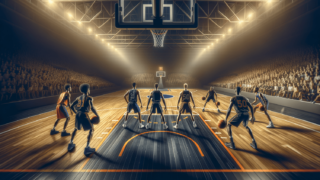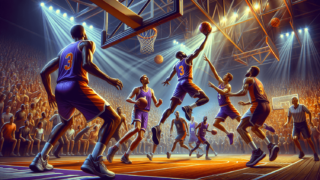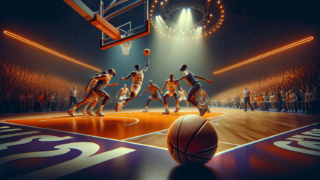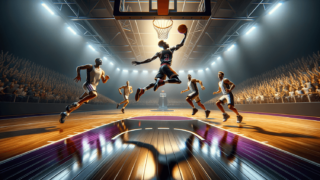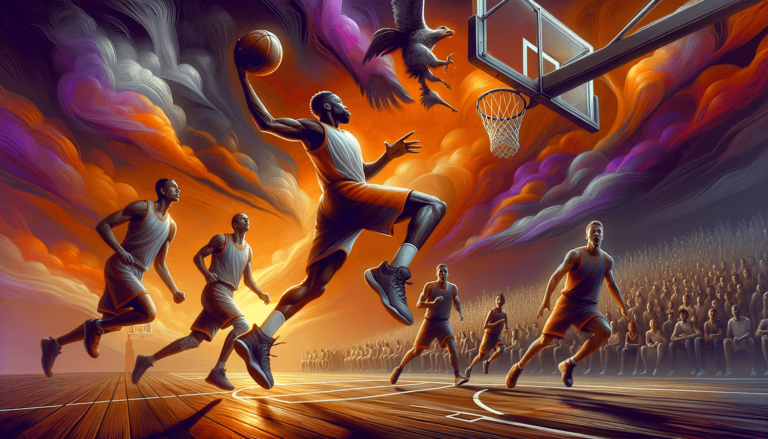
How to Improve Your Basketball Finishing Moves?
Written by: Basketball Universe
Last updated:

Whether you’re a seasoned baller or a newcomer to the hardwood, mastering the art of basketball finishing moves can elevate your game to unimaginable heights. These high-octane plays not only look spectacular on the court, but they also play a crucial role in scoring points and outperforming your opponents. In this comprehensive blog post, we’ll delve deep into the mechanisms of these awe-inspiring moves and explore how honing your skills will make you an unstoppable force on the court. So, lace up your sneakers and get ready to add some finesse to your game as we embark on this exciting journey to master the art of basketball finishing moves!
How to Improve Your Basketball Finishing Moves?
To improve your basketball finishing moves, focus on these key areas: strengthening your physical attributes, perfecting your footwork and body control, expanding your finishing move repertoire, learning from the pros, and gaining game experience. Engage in regular drills and strength training to enhance your agility, speed, and balance. Study and practice various finishing moves such as layups, euro steps, and floaters, and observe professional players using these techniques in-game. Lastly, consistently participate in basketball games to develop your ability to recognize and execute the appropriate finishing move in any given situation.
Building the Foundation: Physical Attributes and Conditioning
One of the main components of executing precise basketball finishing moves is possessing a strong physical foundation. In this section, we will break down the various aspects of conditioning and examine how they contribute to your overall game.
Agility and Speed
Your ability to quickly change direction and accelerate defines your agility, which is essential for eluding defenders and navigating through different basketball situations. Speed enables you to reach the rim faster or outrun a defender. Incorporate agility drills, such as ladder and cone exercises, and speed training, like sprint intervals and resistance band exercises, into your routine to improve these areas.
Strength and Explosiveness
Strong core, leg, and upper body muscles allow for efficient movement and control during layups or dunks. Boost your strength with exercises like squats, push-ups, planks, and lunges. Focus on plyometrics to develop your explosiveness, which translates to higher jumps, rapid lateral movement, and powerful finishes. Examples of plyometric exercises include box jumps, jump squats, and lateral bounds.
Endurance
Stamina allows you to endure the physical demands of basketball, ensuring that you’re able to consistently perform at your best. This is especially important when it comes to delivering high-quality finishing moves during extended periods of exertion. Engage in aerobic exercises like jogging, swimming, or cycling to boost your cardiovascular endurance.
Mastering the Art of Footwork and Body Control
Footwork and body control are vital when executing finishing moves, as they enable you to deceive opponents, maintain balance, and create space for your shots. We’ll outline various exercises and techniques to refine your footwork and enhance your body control on the court.
Two-Foot Finishes
Being comfortable with both feet when finishing around the rim provides a significant advantage. Practice jumping off both feet in various situations, such as driving from different angles, rebounding the basketball, or executing moves like the Euro step.
Mikan Drill
This classic drill is perfect for refining your overall footwork and body control near the rim while also improving hand-eye coordination. Stand under the basket, and make layups alternating between your right and left hand, focusing on keeping your feet moving and maintaining a soft touch.
Balance Drills
Incorporate balance exercises, such as single-leg stances, BOSU ball workouts, and yoga, into your routine. These drills will help you maintain stability during complex finishing moves and ensure smoother transitions on the court.
Expanding Your Finishing Move Repertoire
To become an all-round scoring threat, you need a versatile arsenal of finishing moves. Let’s explore some effective techniques and their variations to help you dominate the paint.
Layups
The layup is a fundamental scoring move in basketball. To improve your layups, work on various finishes such as overhand, underhand (finger roll), and reverse layups. Get creative and practice more complex moves like the up-and-under, same foot-same hand layups, and spinning layups.
Euro Step
Popularized by European players, the Euro step involves side-stepping your defender to create space for your shot. Focus on timing and body positioning to perfect this deceptive move, and incorporate variations such as opposite-foot layups and jump stops.
Floaters
Floaters are a valuable tool for scoring over taller defenders. Refine your one- or two-footed floaters by aiming for a higher arc and a soft touch. Experiment with teardrop floaters and running hook shots to expand your skill set.
Learning from the Pros
Studying professional players can offer invaluable insights into the art of basketball finishing moves. Look at the nuances of each player’s approach and visualize how you can apply these techniques to your game.
Watch Game Footage
Observe how elite players execute their finishing moves in games. Pay attention to their footwork, speed, positioning, and decision-making. Identify patterns and tactics, such as when they use certain moves or how they exploit particular matchups.
Break Down Film
Analyze film of pros executing similar moves in slow motion. Examine each step and identify key aspects of their technique. Gain a deeper understanding of the mechanics of these moves and apply this knowledge to your practice sessions.
Study Player Interviews and Masterclasses
Many professional players share insights and tips on their unique moves through interviews and masterclasses. These resources can shed light on their thought processes, decision-making, and specific techniques, helping you expand your skill set.
Getting Game Experience
To truly harness your basketball finishing moves, you must consistently apply them in game situations. Regularly participating in games will enable you to make better decisions and execute the most appropriate finishing move for each circumstance.
Scrimmages
Join organized scrimmages or open gym sessions to gain experience in a casual, yet competitive setting. Use these opportunities to test your finishing moves and garner feedback from teammates and other players.
League Play
When comfortable, consider participating in a local basketball league or joining a club team. These structured environments offer regular games and opportunities to practice your finishing moves against opponents of various skill levels.
Self-Reflection and Analysis
Reflect on each game experience by evaluating your successes and shortcomings. If possible, analyze game footage to identify areas for improvement and refine your finishing moves accordingly. Embrace constructive feedback from coaches and teammates to further enhance your game.
Final Thoughts: Consistency and Patience
Improving your basketball finishing moves requires dedication and consistent effort over time. Embrace a growth mindset, and remember that mastering these skills may be challenging, but the payoff in terms of your basketball prowess will be well worth the effort. Stay committed to your training regimen, seek guidance when needed, and always strive for growth on and off the court.
Additional Drills and Strategies for Effective Finishing
Let’s dive into some extra drills and strategies that you can incorporate into your training to further enhance your basketball finishing moves. These complementary techniques and workouts will help refine your skills and make you a more complete player.
Emphasizing Ambidexterity
Developing the ability to finish with either hand is crucial for keeping defenders off balance and increasing your scoring options. Make an effort to practice every finishing move with both hands, and spend extra time working on your nondominant hand to minimize any disparities in skill.
Bank Shots and Angles
Utilizing the backboard effectively can help you finish more efficiently around the rim. Concentrate on developing a soft touch off the glass during layups and floaters, and experiment with various angles to find the most effective approach for each type of shot.
Body Contact Drills
Finishing through contact is a key aspect of basketball, as you’ll often encounter physical defense during matches. Work on contact drills, such as finishing layups with a defender lightly bumping you or attempting shots while holding a weighted medicine ball to simulate resistance.
Adjusting Speed and Deceleration
Being able to quickly change speeds contributes significantly to successful finishing moves. Practice decelerating from a fast break before executing a layup or Euro step, and focus on accelerating into the paint from a standstill or half-court situation.
Enhancing Court Vision and Awareness
Recognizing the right time to use specific finishing moves is crucial for success on the court. In addition to practicing your moves, work on your court vision by participating in games and analyzing footage. Identify when particular moves are effective, and learn to read the court to make better decisions during gameplay.
Keys to Success: Dedication and Adaptability
Improving your basketball finishing moves is an ongoing process that demands commitment and adaptability. Prioritize honing your skills, apply the lessons learned from various resources, and maintain a continuous hunger for improvement. By cultivating these qualities and incorporating the strategies outlined in this article, you’ll undoubtedly progress towards becoming a versatile scoring threat on the basketball court.
Frequently Asked Questions
Below, we’ve compiled a list of frequently asked questions to address any lingering queries you may have regarding improving your basketball finishing moves. These answers will provide further insight and clarification to enhance your understanding of the topic.
1. Why are basketball finishing moves important?
Finishing moves play a crucial role in scoring points and outperforming your opponents. Mastering various types of finishes allows you to score more effectively around the rim, even when facing taller or more skilled defenders. Additionally, proficiency in finishing moves contributes to your overall offensive versatility.
2. Can finishing moves be practiced individually, or do they require a training partner?
Many finishing moves can be practiced individually, such as layups or floaters. However, incorporating a training partner can simulate game conditions and help you develop the ability to finish through contact, which is essential for success on the court.
3. How long does it take to improve one’s basketball finishing moves?
The duration required to improve finishing moves varies for each individual, depending on factors such as skill level, training intensity, and consistency. However, with dedication, focus, and regular practice, noticeable improvements can typically be observed over the course of several weeks or months.
4. How can I make my finishing moves more resistant to blocks and steals?
To make your finishing moves harder to block or steal, work on improving your speed, agility, and footwork. Additionally, focus on expanding your finishing move repertoire and mastering various techniques to keep defenders guessing.
5. If I can already perform basic layups, do I need to learn more advanced finishing moves?
While basic layups are a fundamental part of basketball, learning advanced finishing moves adds diversity to your offensive game, making you a more unpredictable and effective scorer. Mastering a wide range of finishing moves allows you to capitalize on different situations and match-ups on the court.
6. Are there any specific finishing moves that work better for shorter players?
Shorter players can benefit from using floaters, Euro steps, and reverse layups, as these techniques help create separation from taller defenders or enable scoring over them by utilizing the backboard and higher shot arcs.
7. How often should I practice basketball finishing moves?
For optimal improvement, it’s advised to practice your finishing moves consistently, ideally as part of your regular training routine. Aim to spend a portion of each session working on specific moves, focusing not just on repetition, but also on refining form and technique.
8. Can I use the same principles for improving finishing moves when learning post moves?
Yes, many of the same principles, such as developing strength, balance, and agility, as well as honing footwork and body control, can be applied to learning post moves. Similarly, expanding your repertoire and gaining game experience are essential for mastering both finishing moves and post moves.
9. Is there a specific age when players should start learning basketball finishing moves?
There is no specific age to begin learning basketball finishing moves. However, it’s recommended to start with basic fundamentals like layups and then progress to more advanced moves as skills and abilities develop. Early exposure to these moves can help form a strong foundation for future success in the sport.
10. How can I measure my progress in improving my basketball finishing moves?
Track your progress by setting specific goals, such as mastering a certain move or increasing your scoring average in games. Additionally, seek feedback from coaches, teammates, or fellow players, and consider recording and analyzing your practice sessions and game footage to identify areas of improvement or success.
Featured Posts
- No pillar pages found.
